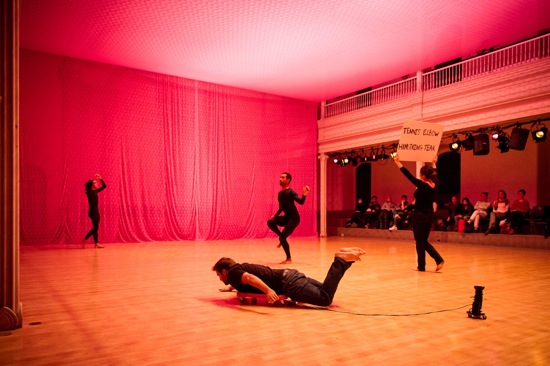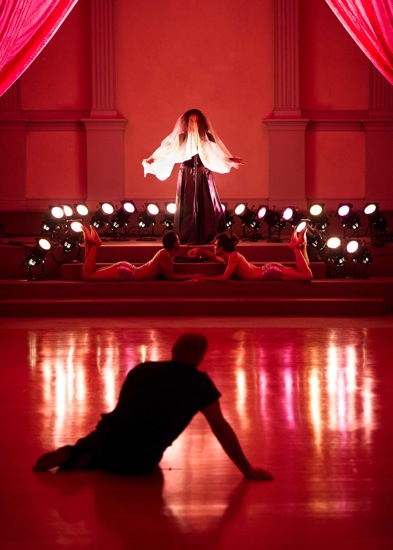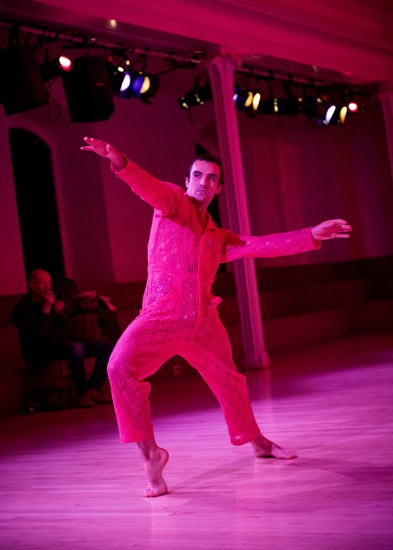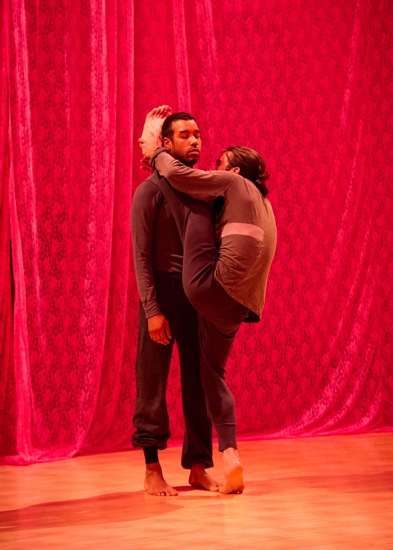Rashaun Mitchell and Silas Riener collaborate on Way In.

Way In at St. Mark’s Church: Silas Riener (L), Rashaun Mitchell, Davison Scandrett on skateboard, Claudia La Rocco with sign. Photo: Ian Douglas
I wasn’t hung up on pink when I was a little girl. Much later, I read that studies had shown the color to have a calming effect on people in need of calming, such as jail inmates. And, sure enough, when I found myself sharing a pinkish bedroom for a year or so with another dancer, I frequently slept until 11 A.M.
Entering St. Mark’s Church to see Danspace Project’s presentation of Way In by Rashaun Mitchell and Silas Riener, I have a new reaction to pink: intimidation. A pink lace curtain conceals the altar platform. A pink fabric ceiling hides the vaulted one. A gender statement? A religious one (God’s boudoir)? I’m not intimidated by that thought as much as I am by the sense that Mitchell and Riener are smarter than I am, and I may never figure out what pink means to them. This is even before the lighting beams down through the ceiling and turns everything rosy.
Way In presents Mitchell and Riener as collaborating choreographers, performers, and lovers—employing their physical virtuosity, but embedding the personal elements of their relationship in formal structures. This, one might expect of two former dancers in Merce Cunningham’s company. They are concerned, I think, with the subject-object aspect of performance—they present (and represent) both an authorial presence and objects for our gazing and conjecturing. To heighten this tension, they have brought two additional collaborators into the piece as performers: Davison Scandrett, lighting designer and more, and Claudia La Rocco, poet and critic.
La Rocco promenades around holding up signs that initially inform us of exits and ask that we turn off our cell phones. Since we sit along the church’s two long sides, she has to make half turns, which, along with her entering and exiting walks, gives her a fashion- runway breeziness. The periodically offered signs get smaller and say things like “tennis elbow, hamstring tear.” A tiny one (about 1 ½ inch by 3 inches) is held meaningfully up to certain spectators. I can just barely read “partial view;” this information, because of the pillar I’m slightly behind, definitely applies to me. Scandrett makes his first appearances, belly-down on a skateboard of sorts that can pull a tiny spotlight on wheels, which, at one point, he plugs in and focuses. Not surprisingly, it sheds red light.
Baroque music is playing in the distance, barely audible. Since we’re not given programs until we exit, I only discover later that what we’re almost hearing (another room, another century) is a portion of a comedie-ballet by Jean-Philippe Rameau, La Princesse de Navarre (1744). There is, from time to time, a certain courtliness to the dancing. Riener and Mitchell come flying on, Riener’s hair—now quite long—choosing its own flight patterns (he soon restrains it with a rubber band). “A universe of two, alone in the crowd. . . .” is among the statements that La Rocco’s taped voice makes.
The two men dance with uncanny beauty and oddity. They scamper and prance, explode into jumps (Riener has tremendous elevation). They spin. They balance for long, thoughtful moments. They lock their limbs around each other in complicated scrimmaging. As with everything in the piece, they seem to inveigle us into considering multiple meanings: fighting, making love, practicing a dance, embodying contradictions.
When they stop and hug, La Rocco looks fondly at them, and pink light rains down. Her taped voice goes on to describe dancing she’s seen them do in a rehearsal and to meditate on that dancing. The sound of galloping horses cuts her off. After what seems a long, motionless time, Scandrett and La Rocco break apart the hug.
Now Mitchell and Riener enact helpless love to movie music by Franz Waxman. Opposite each other on diagonals, they stretch their arms out to each other, straining so hard they might pull the said limbs out of their sockets. Riener races to position himself in such a way that he has to do his reaching around the pillar that he’s pressing himself against. Mitchell, far away on one of the carpeted platforms, yearns similarly. It’s too much for La Rocco; she’s prone on the floor. The two men give up.
Or rather, they give up exaggerating that awkward engineering of fruitless desire and dance in revealing ways. Riener high on the balls of his extravagantly arched feet slowly rotates; nothing else about him stirs; he might be a lighthouse revolving its beam in search of storms at sea. Mitchell prowls around. After he stops, and the lights suddenly brighten, Riener tries to climb up him, throwing a leg over Mitchell’s shoulder; Mitchell offers no help.
La Rocco—as you might guess—plays the critic as hostess. She lounges on one of the two platforms, drinking tea from a china cup and occasionally eating candied chocolate balls from a little dish. There’s a piece of cake, too; she and Scandrett share it, after she wakes him from a nap on the other platform. She’s so bored and superior lounging there that I think of Marie Antoinette announcing “let them eat cake,” when told that the poor lacked bread. Apparently for La Rocco’s scrutiny, Mitchell and Riener face each other across the space and walk into an encounter. Then retreat and try again. And again. Some of the things they do are difficult—such as lying on their backs, pressing their feet together in the air, and lifting their haunches till they form a bridge.
“No,” says La Rocco. “Sorry.” They keep trying. Mitchell barges in with a sloppy kiss; Riener fends him off. Mitchell climbs on Riener, who is standing one leg and revolves quite elegantly with Mitchell on his back (!). The lighting turns green, and La Rocco, slowly, ironically claps her hands.
Much of what the men do suggests not only tenderness, support, and need in physically challenging ways, but also the difficulties involved in maintaining any relationship. For instance, they press their cheeks together and then move awkwardly through off-kilter positions, maintaining that link. Mitchell creeps up and nuzzles Riener, who puts his hand in Mitchell’s mouth and pulls him around by that jaw-grip.
There’s more. Much more. More light extravaganzas (greenish, yellow, and pink gels on the lamps). More costume changes: behind the pink curtain, Riener and Mitchell bustle around and reappear in pink lace outfits that blend with their environment. More talk: Recorded voices (Scandrett and La Rocco) converse (only I think the words belong to Mitchell and Riener, which is slightly confusing), while the in-flesh La Rocco and Scandrett play an unfathomable game with the round candies (jacks with no ball); in the end, he has a fit of temper and scatters them all over the place. More amazing dancing: beauty pulled off kilter, bodies streamlined and flexible, feet as articulate as tongues. Music: (louder now) from Jean-Féry Rebel’s 1715 Les Caractères de la Danse.
Way In is building toward something. What can it be? Riener and Mitchell roll around sensuously, squirming out of their pink jumpsuits. Meanwhile, behind the now-draped-up curtains, La Rocco, has been putting on a long black dress, the kind a 19th-century widow might wear, but also fluffing her black curls unto wildness. The two dancers, now wearing only trunks made of what looks like semi-clear plastic with dark patterning like (maybe) dollar bills, lash and twine themselves around the two pillars that define the entrance to the nave. Lying on their backs, they walk their feet up the white columns and attempt maneuvers that occasionally end with a clunk. Their bodies are so sweaty by now that they might be slicked with oil. (This is not, I think, what the Bible meant by “pillars of the church.”)

The end of Way In: Claudia La Rocco veiled, Rashaun Mitchell (L) and Silas Riener on steps. Davison Scandrett looking on. Photo: Ian Douglas
Scandrett is rearranging a battery of lights on the altar platform. (Is this when he tied a piece of pink lace over his head as a mask? Later he will don a silver one). By the time Riener and Mitchell have superlatively slithered and tangled their way to the altar steps, Scandrett has arranged the lights in a semi-circle and aimed them on a high diagonal. In the middle is La Rocco, with a white veil covering her head. Although Riener and Mitchell stretch along the step like decorative iguanas guarding the door of a Mayan temple (facing each other but looking up at La Rocco), she assumes a role more suitable to a Christian church. “Dearly beloved, we are gathered here,” she begins into a microphone; soon her voice is competing with a babble of her own echoes and other sounds. A witchy voice surfaces: “the law must be enforced.” The lights steam up in mystical zeal. From critic to priestess. . .who’d have thought it?
How did we arrive at this artful wedding anyway? Think back. What was that allusion to W.H. Auden? Does the ambience of a place affect artists creating within it? Mitchell and Riener rise, face us, and lead the procession of four through the church and into the dressing room.
To quote David Hume’s “Essay on Taste” (with which these four collaborator are familiar), a critic “. . .must preserve his mind free from all prejudice, and allow nothing to enter into his consideration, but the very object which is submitted to his examination.”
And that object is. . . .? The mind teems. Think about color, for instance. Pink for the press kit’s envelope. Pink for lacy coverings. Pink for blushing. Pink for the flesh of lips. Pink for tongues. Pink for tropical blossoms. Pink for dawn. My brain feels wracked after all Way In’s rich complexity, my body stimulated, my heart happy, my critical eye challenged. How far in am I? No telling.



God I enjoyed reading this!
As originally published in Arts Journal, my review of Way In followed the program for the performance in identifying the composer of Les Caractères de la Danse as Jean-Baptiste Lully. Alastair Macaulay kindly reminded me that that ballet was written by Jean-Féry Rebel, a pupil of Lully’s. Also, I identified Lully and Rameau as rivals. Since Rameau was a toddler when Rameau died, this was not to be. However the conservative Lullists, in a sense, made them into rivals by arguing furiously with the supporters of Rameau’s “new” musical style.